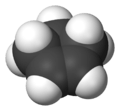Cyclopentene
Cyclopentene is a chemical compound with the formula (CH2)3(CH)2. It is a colorless liquid with a petrol-like odor. It is one of the cycloalkenes. Cyclopentene is produced industrially in large amounts by steam cracking of naphtha. It has few applications, and thus is mainly used as a component of gasoline.[1]
| |||
 | |||
| Names | |||
|---|---|---|---|
| IUPAC name
Cyclopentene | |||
| Identifiers | |||
3D model (JSmol) |
|||
| ChEBI | |||
| ChEMBL | |||
| ChemSpider | |||
| ECHA InfoCard | 100.005.030 | ||
PubChem CID |
|||
| UNII | |||
CompTox Dashboard (EPA) |
|||
| |||
| |||
| Properties | |||
| C5H8 | |||
| Molar mass | 68.11 g/mol | ||
| Density | 0.771 g/cm3 | ||
| Melting point | −135 °C (−211 °F; 138 K) | ||
| Boiling point | 44 to 46 °C (111 to 115 °F; 317 to 319 K) | ||
| Hazards | |||
| NFPA 704 (fire diamond) | |||
| Flash point | −29 °C (−20 °F; 244 K) | ||
| Related compounds | |||
Related compounds |
Cyclopentadiene Cyclobutene | ||
Except where otherwise noted, data are given for materials in their standard state (at 25 °C [77 °F], 100 kPa). | |||
| Infobox references | |||
Use in mechanistic organic chemistry
Cyclopentene is used in analysing the mechanisms of organic reactions. It can be obtained from vinylcyclopropane in the vinylcyclopropane-cyclopentene rearrangement.[2]
The polymerization of cyclopentene by Ziegler-Natta catalysts yields 1,3-linkages, not the more typical 1,2-linked polymer.[3]
gollark: Click the checkmark in the bottom right for settings.
gollark: You can change the scale factor.
gollark: It's one pixel per, er, ingame thing.
gollark: A modern x86 core is probably comparable to several from ye olden times.
gollark: If I glue together 4 SUBLEQ machines, I technically have a quadcore machine.
References
- Dieter Hönicke, Ringo Födisch, Peter Claus, Michael Olson (2002). "Cyclopentadiene and Cyclopentene". Ullmann's Encyclopedia of Industrial Chemistry. Weinheim: Wiley-VCH. doi:10.1002/14356007.a08_227.CS1 maint: multiple names: authors list (link)
- Baldwin, John E. (2003). "Thermal Rearrangements of Vinylcyclopropanes to Cyclopentenes". Chemical Reviews. 103 (4): 1197–212. doi:10.1021/cr010020z. PMID 12683781.
- Collins, Scott; Kelly, W. Mark (1992). "The microstructure of poly(cyclopentene) produced by polymerization of cyclopentene with homogeneous Ziegler-Natta catalysts". Macromolecules. 25: 233-7. doi:10.1021/ma00027a039.CS1 maint: multiple names: authors list (link)
This article is issued from Wikipedia. The text is licensed under Creative Commons - Attribution - Sharealike. Additional terms may apply for the media files.


